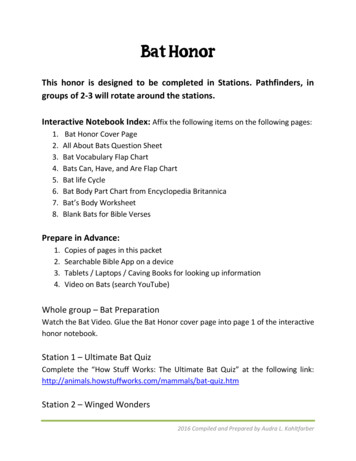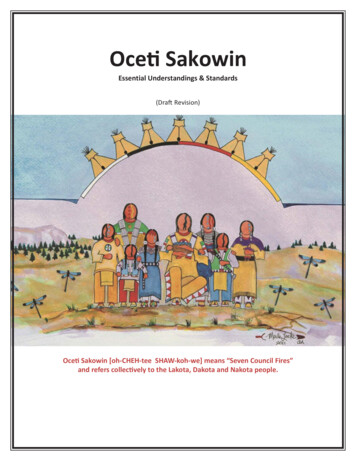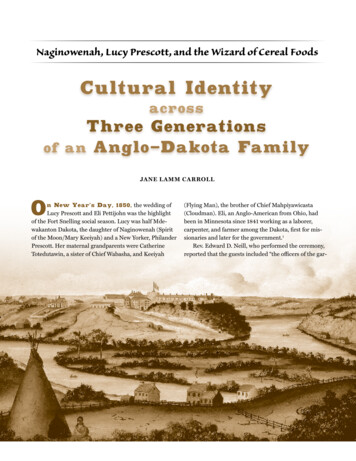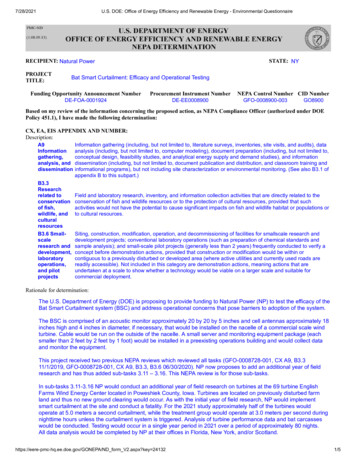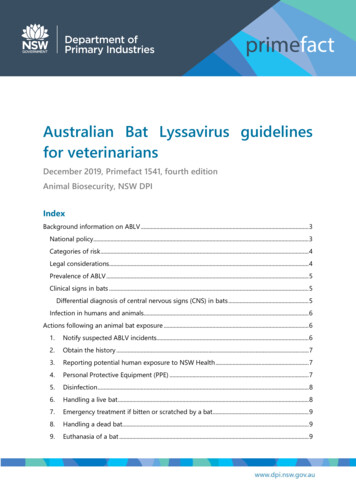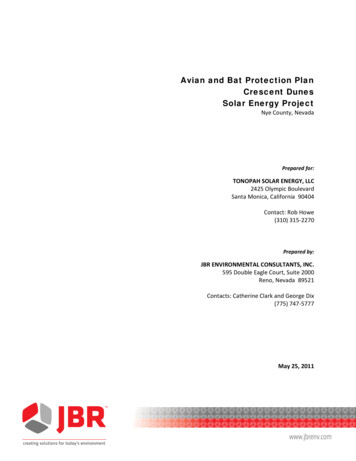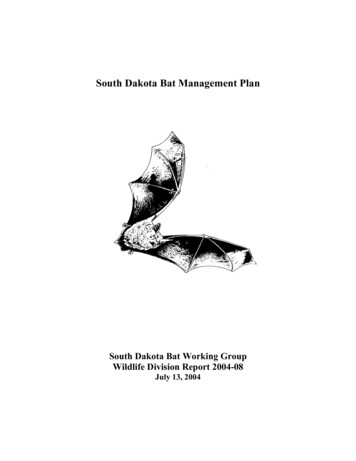
Transcription
South Dakota Bat Management PlanSouth Dakota Bat Working GroupWildlife Division Report 2004-08July 13, 2004
South Dakota Bat Working GroupSouth Dakota Bat Management Plan Page iiTable of ContentsPageSignature Page . ivPreface. vAcknowledgements. viExecutive Summary . viiList of Participants . viiiGeneral Bat Information and Management Justification . 1Introduction . 1Background Information . 1Values and Concerns Associated with Bats. 1Natural History of Bats . 2Bats and Health Issues. 5Bat Studies Conducted in South Dakota . 7Bat Species and Species Status in South Dakota . 7Species List . 7Current State Status . 8Current Federal Status . 9General Reasons for Bat Declines . 10Bat Management Plan . 11Introduction. 11Goal. 11Threats to Bat Populations in South Dakota. 12Management Needs . 20Research Needs . 28Education Needs. . 33Summary Statement . 34Progress Evaluation . 35List of Potential Cooperators . 36List of Personal Communications. 37Literature Cited . 38Appendices. 47A. Taxonomy . 47B. Species Accounts . 47Eastern Red Bat . 47Hoary Bat . 49Silver-haired Bat . 50Northern Myotis . 52Little Brown Myotis . 53Western Small-footed Myotis . 54Fringed Myotis . 56Long-eared Myotis . 57Long-legged Myotis . 58Big Brown Bat. 59Evening Bat . 61Townsend's Big-eared Bat. 62
South Dakota Bat Working GroupSouth Dakota Bat Management Plan Page iiiC. Identifying Bats . 63D. Management Recommendations . 65E. Federal Cave Resources Protection Act. 67F. National Cave and Karst Research Institute Act. 73G. Proper House Exclusions of Bats . 74H. Additional Rabies Information. 77I. Conservation Digest Articles . 81J. Literature Cited. 85
South Dakota Bat Working GroupSouth Dakota Bat Management Plan Page ivSignature PageProtecting wildlife diversity in South Dakota is important to conservationists alikethus we the undersigned vow to work tow ard protecting bat fauna throughout the state byimplementing action items (e.g., strategies) in this plan.CooperatorsDate.South Dakota Bat Working Group (SDBWG), President & Steering Committee (Management)Black Hills National Forest, Wildlife Biologist.SDBWG, Vice President & Steering Committee (Research & Website)South Dakota State University, Associate Professor.SDBWG, Secretary/TreasurerSouth Dakota Game, Fish and Parks (SDGFP), Wildlife BiologistSDBWG, Steering Committee (Research & Funding)SDGFP, Senior Wildlife BiologistSDBWG, Steering Committee (Research & List-Serve)SDGFP, Wildlife BiologistSDBWG, Steering Committee (Research)Batworks, Owner & Bat BiologistSDBWG, Steering Committee (Education)SDGFP, Program Specialist.
South Dakota Bat Working GroupSouth Dakota Bat Management Plan Page vPrefaceTwelve bat species can be found throughout South Dakota comprisingapproximately 12 percent of the state’s mammal fauna. As efficient predators of nightflying insects, bats are integral components of the environment and provide a substantialeconomical service as they feed on agricultural and forest insect pests.Bat populations depend largely on their ability to find safe, secure roostinghabitat. Unfortunately, this habitat is in jeopardy in many areas. Depending on thespecies of bat, bats may roost in a wide variety of sites from rock crevices and cavities(caves, abandoned mines) to trees, both living and dead (snags), and structures such asbuildings, bridges and even the artificial ‘bat houses’ that are becoming somewhatpopular. It is important to note that due to micro-site (temperature) conditions and otherselection criteria that are not fully understood, bats can be very selective regarding roostsites.Besides roosting habitats, bat foraging habitat is also being degraded or destroyed,which reduces the availability of insect prey and drinking water. As well, other factorssuch as lack of protective regulations and a general public image of being rabid anddangerous pose threats to bats.Therefore, an increased effort to protect, conserve and manage bats and theirhabitats in South Dakota is required. The South Dakota Bat Management Plan (SDBMP)is designed to identify risks to bats, develop objectives and strategies to conserve bats andto educate people about them, and make management recommendations associated withprotecting bats and their habitats in South Dakota.All future bat conservation efforts in South Dakota will depend on cooperationamong agencies, groups, organizations, and individuals in order to achieve theseobjectives and strategies.The South Dakota Bat Working Group initiated the development of thismanagement plan and formed the framework through meetings and group discussions.Sixteen agencies, organizations, and individuals were involved with developing the SouthDakota Bat Management Plan. These and other agencies, individuals, and organizationswill be the cooperators in this effort. Bat conservation has become an important wildlifemanagement goal as agencies, organizations, and individuals recognize the ecologicaland economic value of bats. This State Management Plan is the first step. As timeprogresses, and we grow in our understanding of bats and their habitat needs the SouthDakota Bat Working Group will utilize a pro-active approach to managing wildlife –adaptive management – to improve this plan.
South Dakota Bat Working GroupSouth Dakota Bat Management Plan Page viAcknowledgementsThe South Dakota Bat Working Group would like to acknowledge the efforts ofindividuals in the development of this plan. Working Group members includeresearchers, biologists, educators, and managers from different areas of the state. SouthDakota Game, Fish and Parks personnel were particularly dedicated to the formulationand writing of the plan. People involved with the development of this plan include:Alyssa Kiesow, Barb Muenchau, Brad Phillips, Chad Tussing, Cheryl Schmidt, DougBacklund, Eileen Dowd-Stukel, Joel Tigner, Lon Kightlinger/Linda Schaefer, NatalieGates, Sara Reindl, Scott Pedersen, Stephanie Middlebrooks, and Vicki Swier.Also, many individuals of state, federal, and other organizations reviewed draftsof this plan throughout its development and/pr provided their expertise in various areascovered in the plan. Those individuals include Barb Muenchau, Brad Phillips, BrianScott, Cheryl Schmidt, Connie Vicuna, Dan McCormick, Dan Foster, Doug Backlund,Doug Hansen, Eddie Childers, Eileen Dowd Stukel, George Vandel, Karen Hall, HeatherJohnson, Joan Bortnem, Joel Tigner, Kim Schultz, Lon Kightlinger, Marc Ohms, PaigeHoskinson, Renee Ohms, Rodd Horricks, Scott Pedersen, Shelly Diesch, Stan Michals,Steve Hirtzel, Steve Wilson, and Vicki Swier.
South Dakota Bat Working GroupSouth Dakota Bat Management Plan Page viiExecutive SummaryBat populations are declining locally, and continentally, due to habitat loss andfragmentation, roost disturbances, public lack of awareness, and poor regulatorymeasures. The South Dakota Bat Working Group and South Dakota Game, Fish andParks recognize the ecological and economic benefits of bats and are initiating efforts toprotect habitats and conserve bats in South Dakota. This South Dakota Bat WorkingGroup seeks to protect bats and bat habitat through action, education, and cooperationwith federal, state, and private landowners. Objectives include raising awarenessconcerning the role bats play in maintaining healthy ecosystems and working with publicland managers and private landowners to reduce possible disruptions to bats and theirhabitat. South Dakota Game, Fish and Parks, specifically the Wildlife DiversityProgram, seeks to inventory, protect, and manage species and habitats in a manner thatmeets the needs and desires of the people of the state while protecting South Dakota’sbiological diversity. Efforts towards conserving bats and their habitats in South Dakotainclude the development and implementation of a state bat management plan.The South Dakota Bat Management Plan includes general backgroundinformation, a management plan outline, and numerous appendices. General backgroundinformation includes details concerning bats and their habitat, health issues, managementjustification, and bats’ legal status. The management plan outlines objectives, strategies,and makes management recommendations by taxon or habitat of bat species in themanagement, research, and education sections. Numerous appendices include speciesaccounts, written articles regarding bats, and current federal laws associated with bats andtheir habitat.The main goal of the South Dakota Bat Management Plan is to provide guidancepromoting long-term conservation of South Dakota bat species through research,management, and education. Through the implementation of this plan, bat conservationefforts will be strengthened and cooperation among agencies, organizations, andlandowners, as well as regulatory measures, will be enhanced. The goal is a reversal ofdownward trends of particular bat populations noted in bat survey work conductedthrough the years.Bats receive protection through proper habitat management, research, andeducation, therefore each objective and strategy contributes to the achievement of theplan’s overall goal. The goals and objectives apply to all bats in South Dakota. Whilethere has been no attempt to prioritized efforts by species, it is presumed thatconservation efforts will be keyed to local conditions and situations. Resource managerswill decide which objectives and strategies to apply under their authority and which onesare most urgent in their area.Because the South Dakota Bat Management Plan is designed to be adaptive, eachparticipating agency, group, individual, or organization will be asked to provide annualupdates and progress reports regarding objectives and strategies they are conducting orhave fulfilled. The updates will help refine goals, objectives and specific strategies. Inaddition, as new information is learned regarding habitat requirements, population data,or other vital information it will be incorporated into future plan revisions.
South Dakota Bat Working GroupSouth Dakota Bat Management Plan Page viiiList of ParticipantsThe South Dakota Bat Management Plan is a cooperative effort between local, state, andfederal entities. Alyssa Kiesow (SDGFP) drafted most of the plan, though many individualsthroughout the drafting process provided a great deal of help. Doug Backlund (SDGFP) and JoelTigner (Batworks) provided identifying keys that appeared in the Mammals of South Dakotabook, and Joel Tigner, Eileen Dowd Stukel (SDGFP), and Alyssa Kiesow provided articles thatappeared in the South Dakota Conservation Digest. Individuals who contributed to the plan arelisted below. These individuals participated in meetings and provided numerous commentsregarding bat conservation and their agencies are potential cooperators in fulfilling this plan.Alyssa KiesowSouth Dakota Game, Fish and Parks (Wildlife)523 E Capitol Ave – Foss BuildingPierre, SD 57501-3182Barb Muenchau/Dan FosterWind Cave National ParkRR 1 Box 190Hot Springs, SD 57747Brad PhillipsSouth Dakota Bat Working Group3406 Ivy AveRapid City, SD 57701http://nat hist.sdstate.edu/SDBWG/SDBWG.htmlBrad PhillipsUSDA Forest Service, Black Hills National Forest330 Mt RushmoreCuster, SD 57730Cheryl SchmidtBS BioServ, Inc.18897 Eichler RoadNewell, SD 57760Cheryl SchmidtUSDA Forest Service, Rocky Mountain Research Station1730 Samco RoadRapid City, SD 57702Chad TussingSouth Dakota Game, Fish and Parks (Education)412 W Missouri Ave – Kenyon BuildingPierre, SD 57501-4521Doug BacklundSouth Dakota Game, Fish and Parks (Wildlife)523 E Capitol Ave – Foss BuildingPierre, SD 57501-3182Eileen Dowd StukelSouth Dakota Game, Fish and Parks (Wildlife)523 E Capitol Ave – Foss BuildingPierre, SD /Index.htmJoel TignerBatworks2416 Cameron DriveRapid City, SD 57702Lon Kightlinger/Linda SchaeferSouth Dakota Department of Health615 E 4th StreetPierre, SD 57501Natalie GatesUS Fish and Wildlife Service, Ecological Services420 S Garfield Ave Suite 400Pierre, SD 57501Scott PedersenSouth Dakota State UniversityDepartment of Microbiology/BiologyAgricultural Hall 304 Box 2207BBrookings, SD 57007Stephanie MiddlebrooksRosebud Sioux TribePO Box 430Rosebud, SD 57570Vicki SwierTexas Tech UniversityDepartment of Biology, Box 43131Lubbock, TX 79409
South Dakota Bat Working GroupSouth Dakota Bat Management Plan Page 1General Information and JustificationIntroductionTo help familiarize individuals, general information about bats as a group and specificinformation pertaining to the bat species that occur in South Dakota are included in thismanagement plan. Information includes background knowledge (e.g., natural history), batsand health issues, studies and species in South Dakota, and reasons for bat declines. Thisinformation is provided in the general bat information and management justification section asthe prelude to the actual strategic plan.BackgroundValues and Concerns WorldwideBats play an ecological and economic role in their community, which is not duplicatedby any other animal group. Worldwide, there are nearly 1,000 species of bats that feed onfruit, nectar, other animals, insects, and even blood. In tropical regions (where bats are mostabundant), bats disperse seeds and pollinate flowers by feeding on fruit and nectar, therebyplaying a significant role in resource production, plant evolution, and reforestation. Anestimated 450 products used by humans are produced by bat-pollinated plants (Laubach et al.1994). Notable products include food (e.g., bananas and cashews), wood (e.g., balsa), andbeverages (e.g., tequila). In the New World tropics, three species of vampire bats are found(Laubach et al. 1994), which drink blood. The anticoagulant found in their saliva has beenused for medicinal purposes and has saved lives.In the United States, and more specifically in South Dakota, bats feed on insects. InSouth Dakota the role of bats is relatively unknown, but it is suspected that they play a majorrole in insect population control. For example, it has been reported that little brown bats(Myotis lucifugus) may consume 600 insects (e.g., mosquitoes) in one hour (Tuttle 1988), andmay play a role in urban mosquito control. Big brown bats (Eptesicus fuscus) consume largequantities of beetles and agricultural pests. In one season, one maternity colony of nearly 150bats consumed 38,000 cucumber beetles (Diabrotica spp.), 16,000 June bugs (Phyllophagaspp.), 19,000 green and brown stinkbugs (Pentatomida), and 50,000 leafhoppers(Cicadellidae) (Whitaker 1993). Tree-roosting bats (e.g., red bats [Lasiurus borealis], hoarybats [Lasiurus cinereus], and silver-haired bats [Lasionycteris noctivagans]) may helpmaintain forest health by consuming forest pests. Regardless of specifics, it is clear that batsserve a vital function in our ecosystem.Lack of public awareness and understanding of the value of bats threatens theirpopulations in North America (Luce 1998). Myth, superstition, and folklore continue tocontribute to the decline of bat populations. People often associate bats as blood sucking,rabies infected animals that are blind and often tangle themselves in people’s hair. EuropeanAmerican culture tends to link bats to evil or evil powers, such as witches and vampires.Contrary to such beliefs, bats are actually unique creatures that benefit humans, and in somecultures (Chinese, for example) are a symbol of good luck and prosperity.Other factors that may impact bats include human disturbance or destruction of bathabitat. Humans may vandalize roosts such as caves or mines, exclude bats from buildings atinappropriate times or by improper methods (Williams-Whitmer and Brittingham 1996), anddisturb roosting bats through recreational and commercial activities such as partying in cavesor selective logging. Destruction or degradation of habitat may result from selective harvest
South Dakota Bat Working GroupSouth Dakota Bat Management Plan Page 2of large trees (Adam et al. 1994, Ochoa 2000, Sedgeley 2001), presence of toxins oftenintroduced through pesticide use (O’Shea and Clark 2001, O’Shea et al. 2001), habitatfragmentation, human disturbance or vandalism at caves (Perkins 1985, Gore and Hovis1992), and slowly disappearing or degraded riparian zones (Rich 2002). Because these threatsmay endanger important roosting, foraging, and watering areas, it has become necessary tosafeguard critical habitat in order to conserve bat species in South Dakota.Natural HistoryOverviewBats belong to the group of mammals called Chiroptera, which constitutes nearly 1200species worldwide. Chiroptera literally means hand wing (MWCD 2002). In fact, bat wingsare structured as greatly enlarged hands making them very different from bird wings. As aresult of their highly developed wings, bats are the only mammals that have truly masteredpowered flight. Other types of mammals can glide (e.g., flying squirrels) but are not capableof sustained flight.Bats are often compared to rodents, but rodents are flightless and have large pairedteeth (incisors) designed for gnawing. Bats are more closely related to primates and haveextremely sharp teeth similar to large fangs (canines) found in carnivores. Bats’ teeth are notsuited for gnawing; instead they are used to puncture and cut apart the hard outer coverings(exoskeletons) of insects.Physical CharacteristicsMost bats in South Dakota have dark brown wing membranes and short brown or grayfur, so it is difficult to distinguish between species. Bat wings – large, five-fingered handswebbed with extremely thin skin stretching from fingertip to shoulder – provide lift and thrustfor the animal during flight. Bats use their hind legs and tail, which are enclosed in very thinskin, to maneuver during flight, much like airplanes use ailerons and rudder. Because thewing membranes are so thin, it is easy to see blood vessels along their length. These thinmembranes also pose great risk of dehydration, forcing bats to seek roosts with high humidityand minimal air movement. Since bat wings are so fragile and easily damaged, bats utilizetheir hind feet to move around in their roosts. With short toes and long claws, bat feet arewell adapted for hanging upside down. Bats initiate flight from this position by droppingheadfirst and spreading their wings.Bats evolved from small bodied, large brained, insect eating mammals similar toshrews (Laubach et al. 1994). Much like their ancestors, many species of bats (and all ofSouth Dakota’s bat species) locate prey and avoid obstacles using a process calledecholocation. Echolocation is much like the sonar navigational systems used by whales anddolphins. Bats emit high frequency sounds that strike objects (e.g., prey or obstacles) andreflect (echo) back to them, much like Doppler weather radar systems, telling bats the speed,direction, and size of their target (Simmons et al. 1978). Bats are able to adjust their flightaccordingly. Once it detects prey, the bat captures it by scooping it up with its wing or tailmembranes and transfers the food to its mouth. The bat immediately bites off the insect’swings and legs, and before it loses air speed, quickly chews and swallows the insect’s body.For South Dakota bats, the senses of vision and smell do not play a predominant rolein hunting, but their sense of smell does play a significant role in social communication back
South Dakota Bat Working GroupSouth Dakota Bat Management Plan Page 3at the roost (Bradbury 1977). Most bats apparently lack cones in the retina, a characteristic ofmany nocturnal animals, but they are still able to see.PhysiologyLike humans, the operating body temperature of most bats is 37 C (98 F) (Lyman1970). Maintaining body temperatures through internal regulation, called endothermy orhomeothermy, takes a great deal of energy for bats to keep their bodies cool (panting) andwarm (fat metabolism) (Licht and Leitner 1967). To conserve important resources, bats canallow their body temperatures to fluctuate with ambient temperatures ranging as high as 43 C(110 F) and as low as 0 C (32 F). This process, which is called heterothermy, conservesenergy during times of stress (e.g., reproduction) when it is more important to protect body fatreserves than to sustain comfortable body temperatures. Periods of heterothermy are calledtorpor or hibernation. Torpor saves energy by reducing body temperature, slowing heart andrespiratory rates, and reducing metabolic speed (Humphrey 1982, Luce 1998).Periods of torpor may last from a few days to several months. Before entering longperiods of hibernation, bats must feed excessively to build the large fat reserves needed tomaintain body functions throughout the dormancy period. During hibernation, bats may rouse– though only occasionally and for short periods – to urinate, drink, or move to another roostsite. During this dormancy period, bats are very sensitive to disturbances, which usuallyresults in “emergency exits from torpor.” This emergency activity burns up important energy,and when bats re-enter hibernation, they may no longer have sufficient fat reserves to surviveuntil food and water become available.During the day, bats often sleep and become semi-torpid. While being semi-torpid,bats are able to slightly reduce their oxygen consumption rates and body temperatures. Also,resting bats often groom themselves using their tongue and their toes. Upon awakening, batsraise their temperatures and increase their consumption rates. Thus, some bats spend much oftheir life in torpor or in a condition approaching torpor.ReproductionDuring the breeding season, male testes descend into the scrotum in preparation formating. In South Dakota, bats typically mate in the fall before hibernation, though time ofmating varies among species. Because bats are able to postpone egg fertilization orimplantation, there is also variability as to when after mating the sperm fertilizes the egg(delayed fertilization) and when the fertilized egg begins development (delayed implantation).Pregnancy lasts approximately 50 to 60 days (Wimsatt 1945, Laubach et al. 1994), and 80 to90 percent of the females in a nursery colony are reproductively active, depending on the year(Humphrey 1982). Typically, a single young is born in May, June, or late July and, whilemost species in South Dakota will typically produce only one offspring a year, the red bat(Lasiurus borealis) may produce up to four (Jones et al. 1983).Six of the twelve bat species found in South Dakota are mouse-eared bats of the genusMyotis, which produce one young per year (Guthrie and Jeffers 1938, Wimsatt 1944); in someyears, as few as 25 to 50 percent of the reproductive-aged females produce single offspring(Barclay et al. 2002). Because of this low reproductive rate, bat populations are moresusceptible to dramatic declines in number, which results in subsequent periods of lowreproduction.
South Dakota Bat Working GroupSouth Dakota Bat Management Plan Page 4Mothers usually feed and nurture pups until they become volant and full-grown. Pupsand juvenile bats typically cling to their mother’s underside, feeding alternately between thetwo teats located near the mother’s armpits. (Most females have two functional mammaelocated in the chest region, but females of Lasiurus have four functional mammae.) Femalesmay carry their young while traveling or foraging until the young become too large for theirmothers to remain aloft or too restricting for them to hunt. As a result, young learn veryquickly to fly and capture their prey. At 2.5 to 3.0 weeks of age, juvenile bats are nearly fullgrown. Many species of bats in South Dakota are known to live an average of 20 years, withtheir first pregnancy occurring during the second year (Humphrey 1982).Key HabitatsForaging habitats vary depending on insect availability, weather, and bat species.Usually, bats forage over water (e.g., lakes, streams, etc.), along forest edges, along rockyescarpments and ravines, and near light sources because these features tend to concentrateinsects (Humphrey 1982). Studies in South Dakota and Colorado have shown that small treestands or water bodies are important features for bats in open prairies (Everette et al. 2001,Swier 2003).The importance of watering sources is twofold. Most bats require more water thanother mammals of comparable weight because their wing membranes have great evaporationsurfaces in relation to their weight. Bats are able to drink water while in flight by flying lowover the water, lowering their head, and taking a gulp of water. Watering holes also attractinsects upon which the bats feed.Bats roost in a variety of areas. Trees, rock crevices, caves, mines, and man-madestructures (e.g., attics, walls or crevices in buildings) provide adequate roost sites for bats.However, some bats in South Dakota even roost under rocks on the ground. Becauselandscapes differ in South Dakota, all these roosts are important for maintaining batpopulations in various areas of the state. Typically, day roosts – including nursery roosts,summer male roosts, transient roosts, and winter roosts (Humphrey 1982) – provide moresecurity and stable conditions than night roosts, which offer areas for rest after feedi
To help familiarize individuals, general information about bats as a group and specific information pertaining to the bat species that occur in South Dakota are included in this management plan. Information includes background knowledge (e.g., natural history), bats and health issues, studies and species in South Dakota, and reasons for bat .

